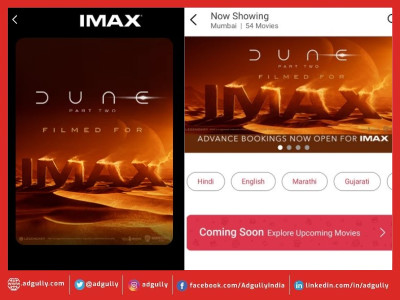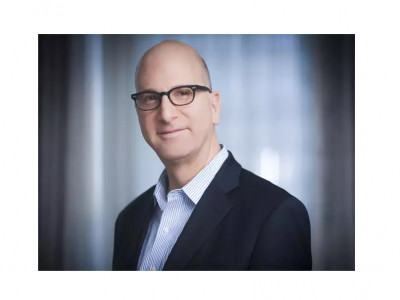AgTalk | We will have ten theatres opening up in 2014: IMAX's Greg Foster
To a nation which eats, sleeps and drinks movies, the movie going experience definitely has to be a notch higher and a complete paisa vasool experience. The trend of broadcasting latest movies on television channels within months of its release makes the audience think twice before going to the cinema hall and wasting a huge sum from the pocket, when they can watch a movie from the comfort of the couch in the house. But IMAX is definitely taking care of the comfort of the audience and catering to a movie watching experience which ofcourse will compel the laziest of person and stingiest of the family member to go out and watch a movie in the theatre.
How will IMAX ensure this and a lot of IMAX’s plans were revealed to us by Greg Foster, Chairman & President, Filmed Entertainment IMAX. IMAX is an innovator in entertainment technology. It combines proprietary software, architecture and equipment to create experiences that take you beyond the edge of your seat to a world you’ve never imagined. Top filmmakers and studios are utilizing IMAX theatres to connect with audiences in extraordinary ways, and, as such, IMAX’s network is among the most important and successful theatrical distribution platforms for major event films around the globe.
Greg Foster is based at IMAX's Santa Monica office, and his primary responsibility is overseeing all aspects of the company's global filmed entertainment activities, including creative, production, film distribution, business affairs, marketing, sponsorship, studio relationships and the revolutionary IMAX DMR® process.
Below are the edited excerpts of our conversation.
Adgully (AG): What are your plans for the Indian market?
Greg Foster (GF): We are extremely committed and focused about the Indian market. We have four theatres that are currently going to open in India and we will have ten theatres opening up by the end of the year. We are very committed to the home grown market and the local home grown movies in the local languages for we have realized that the only way to succeed is to compliment the Hollywood movies with the home grown movies and supplement them with the local language movies made here.
AG: Are you then looking at tapping the opportunity available in the local language films here?
GF: It’s not that we see potential here but we can’t be in business in India without having the local language films. A similar proposition exists in Russia, Japan and China where we make local English films in the native language. The exciting part about this is that often these locally made films have difficult times in getting exported outside their indigenous market. IMAX is a brand with 650 theatres owned in 53 countries, so people know what IMAX stands for and this allows their movies a wider audience in countries like America, Canada, UK, Malaysia, Indonesia, the Middle East and so and so forth and that is why studios like Yash Raj Films (YRF) are interested in IMAX, for it is a great way to find an audience outside the Indian market.
AG: Are there any other market shifts apart from YRF you are focused on?
GF: We haven’t announced any yet and Dhoom 3 will be our first movie in December 2013. {This piece of news came after our interview with Greg} (IMAX Corporation (NYSE:IMAX; TSX:IMX) and Yash Raj Films Pvt. Ltd., India’s largest film studio, on 13th March announced an expansion of their partnership to release Paani as well as an additional Yash Raj Films motion picture to IMAX® theatres across India and other key markets. The agreement brings the total number of films included under the expanded partnership to three, the first of which is the upcoming action thriller DHOOM: 3, which will open in IMAX theatres this winter.) We are currently discussing on many other partnership deals but nothing that we can announce at the moment.
AG: What kind of expansion plans do you have in India?
GF: We will have ten theatres opening up in 2014 and if the market continues to grow then we will have a 50 Euro market and that is going to be our five year goal. When we began in China in 2010 we had ten theatres and currently we have 110 theatres. We are not comparing India to China but I think there is room for much more.
AG: Why didn’t IMAX think of investing in India much earlier?
GF: We did but the unfortunately the development of the multiplex structure in India at that time was focused on either single screens or two or four screens, so 90% of the Indian films produced were exhibited on the four screens and there wasn’t room for more. Now that they are concentrating on building eight to twelve screen multiplexes there is certainly room for IMAX to come in. Moreover four to five years ago IMAX was doing 8 Hollywood films a year and now we are doing 25 Hollywood films a year, so this combines our commitment to do Bollywood films and give the Indian filmmakers a larger canvas for their films through the platform of IMAX.
IMAX stands for quality and quality is synonymous to us so therefore when we associate ourselves with a movie we are concerned about it from its initiation to the stage of its release. We are therefore involved in a film’s design from the pre-production to the post-production stage, so when Dhoom 3 was being extensively shot in the different parts of the world, the filmmaker was conscious of taking shots that catered to the IMAX screen experience and sound quality. And this is so of all the 25 films that we do round the year whether it is Hollywood or the Russian film that we are doing or the four Chinese films we are currently working on.
AG: What kind of distribution is IMAX aiming at in India?
GF: Our key partners are PVR and there are local partners like SPI in Chennai and Hydearbad. We are working with Ramesh Prasad in Hyderabad, looking at several areas in Delhi, Bangalore, and are coming to the Phoenix Malls in Mumbai. We are coming up with several screens in Bangalore, two with PVR and four in Chennai with Kiran Reddy.
AG: What kind of challenges are you facing in the Indian market?
GF: The biggest challenge is the development for it needs to be state of the art internationally and it is taking place slowly, it has been coming on the line now from the last two years. I think as we now have four multiplexes for the mainstream we can now build a lifestyle standard which just does not include shopping but also restaurants for someone who wants to enjoy an after movie evening and that is where we will provide a major attraction. I think the developers here are now looking at all over Asia and they are finding that IMAX is a major anchor at all shopping malls across Asia. Therefore they are now considering leveraging the opportunity available to them and using IMAX as an anchor for them in the shopping malls. So we are working here with a lot of shopping malls and have partnered with PVR which is the largest cinema multiplex in India and enjoys a nationwide presence.
We have to program ourselves for the Indian market and the reality is that we have been playing Hollywood films in India, but 90% of the box office collections in India come from the local language films. So we have programmed ourselves to do local language films in India. I think we are very positive about this combination for it has worked in China and it will work in India as well.
Price is another problem that we are facing here. I know IMAX is going to be an expensive experience but then people can watch a movie that they are really passionate about in IMAX to increase their viewing experience. Moreover IMAX can be that movie experience that you would enjoy on a special day or on an occasion with your family. I don’t think it is out of the reach of many for India offers a wide demographic of economics.
The price in Delhi, Mumbai, and Bangalore is more but as you move towards the second tier cities it will not work. So it clearly is up to the executive and the distribution. We are definitely looking beyond the metros for India is a small market and with one IMAX and right operator it will definitely work very well for us.
AG: Tell us about the technology investment that you doing in India.
GF: We do not really have a number specifically for the Indian market. Tens and millions of dollars are invested to work on the technology to improve things constantly and this is not easy for we have set the bar quite high striving always to make the film watching experience better. It is a movie going experience that we are working on, so the resolution is better; the screen size is bigger and by this I mean that the IMAX auditoriums are biggest in the multiplexes in India. Our laser technology which is the new projection technology which we will begin in 2015 will raise the bar. We say IMAX is the ultimate way of experiencing a movie and just not about sitting in a chair and it took us years and years of experiments to come to this. I By Rabab Rupawala [rabab(at)adgully.com]












Share
Facebook
YouTube
Tweet
Twitter
LinkedIn